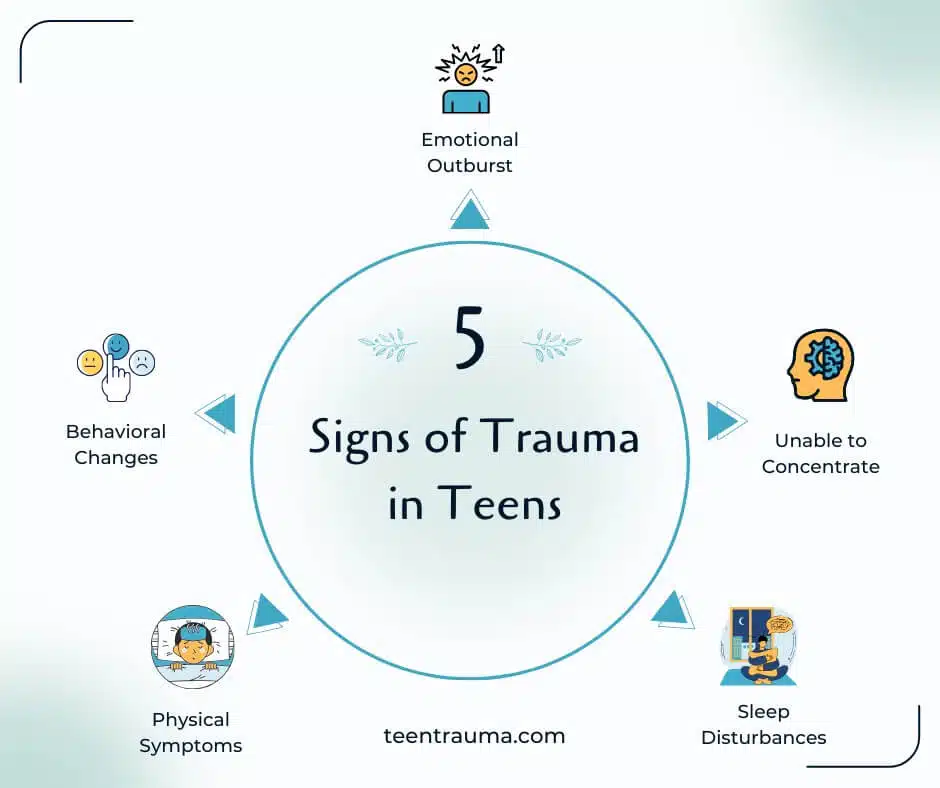A Closer Look at Additional Sources of Childhood Trauma
It’s natural to want to protect our children from harsh realities and from pain. We quickly notice new bruises or scars, but what about the wounds we can’t see?
Behind the smiles and carefree attitudes, some teenagers are battling deeper, more profound, hidden wounds–Teen Trauma.
Trauma is often a silent struggle that goes unnoticed until it is too late. We know all about trauma resulting from physical abuse, but can we recognize the effects of bullying, health issues, natural disasters, and divorce in our teens? These daily occurrences can leave a lasting imprint in our children’s hearts and minds.
While it is common to think of trauma in events such as physical assault or abuse, there are other factors that can come into play in a teen’s life that will lead to trauma. As a parent, you need to understand these triggers so you can spot the signs of abuse early and take action to protect your child from the ongoing effects of trauma.
Here are some less common forms of trauma that teens might experience.
Recognizing Divorce or Abandonment Related Trauma
The loss of a parent
While the loss of a parent through death is clearly traumatic, losing access to a parent through other problems, including divorce or abandonment of the family, is also traumatic.
Children and teens often wonder if they did something to make the divorce happen, and if the divorce was sudden, it can cause distress and shock to the child. In addition, if the parents are traumatized by the events surrounding the divorce, they may not be emotionally healthy enough to help their children manage their sense of loss and grief.
According to PsychCentral, divorce is often connected to trauma in children. It creates a deep sense of loss and grief for the child, and if the parents are fighting, this trauma gets worse. In addition, any abuse witnessed by the child prior to the divorce can lead to trauma as well.
Children who were placed in foster care or for adoption may experience similar symptoms. Not all children will develop trauma, but some will, so parents need to be aware.
A recent study found that 46% of kids whose parents’ divorce was highly combative were more likely to have PTSD. Confirming that many children are affected by high-conflict divorce.1
Learn more: The Teen Trauma Caused by Divorce, Family Break Ups and Other Losses
The Devastating Effects of Bullying in School
Bullying may seem like a rite of passage, but it can lead to significant amounts of trauma to the victim. The fact that bullying follows a child home through their cell phone can make this problem worse. The National Child Traumatic Stress Network indicates that bullying can create a wide range of mental health concerns, including signs of trauma.
In addition, teens who witness bullying can also experience trauma. They may feel guilt over their choice not to act to protect their peer from the bullying behavior.
About 37% of young people between the ages of 12 and 17 have been bullied online, with 30% having experienced it more than once.2
Learn more: The Long-Term Effects of Bullying
Severe Medical Issues
Another area that can lead to trauma in a teen is medical or health concerns. A child facing a life-altering or potentially fatal medical concern may develop trauma as a result. This can make future visits to the doctor challenging as well, as the trip to the medical center may bring back the trauma response.
Children with medical trauma may develop all of the signs of PTSD, and they may also become hypervigilant about their health. Developing hypochondria is very common for these children. They may also have an exaggerated startle response or develop flashbacks.
Natural Disasters, Even if Not Directly Affected
Another concern that some teens have is related to natural disasters. When a teen observes natural disasters, either directly or indirectly, or hears about the effects of these issues, they may fear for their own stability. Natural disasters feel frightening because they are out of the person’s control, and this, especially when combined with any preexisting mental health concerns, can lead to trauma.
Since parents can’t control natural disasters, nor can they protect their children from learning about them from media and friends. Thus, parents need a plan. The best way to cope with this type of trauma is to have an open dialogue about it.
When the news is reporting on a natural disaster, parents can talk about their concerns and give their children a safe place to express their own worries about what may happen.
Trauma from an Accident
Teens can also experience trauma if they are involved in or are witnesses to some sort of accident. A car accident is a common type that they may experience, but that is just one type. Because an accident is sudden and unexpected, it can hurt a child’s sense of stability and control, and that is traumatic.
The teenager doesn’t have to be directly involved, either. Seeing a serious car crash or experiencing a near crash scenario can all spark trauma.
Trauma Due to Neglect
Neglect is a form of abuse that doesn’t leave behind marks or scars but does create trauma. A child is born with a natural desire to have their needs met by their primary caregiver. When those needs go unmet day after day, the end result is trauma.
This one can be hard to identify because what a child views as neglect may not be seen that way by others around them. Children need both physical and emotional care from the adults in their lives, and if one of those adults neglects to fulfill their duty to the child, the child will experience trauma as a result.
Chronic Exposure to Small Traumas
Some traumatic events, in isolation, are not damaging to a developing child. However, when those same small events happen repeatedly, they can lead to trauma.
For example, being teased on occasion may not be pleasant, but it’s probably not going to cause trauma. On the other hand, being teased regularly, especially if it is for something the child can’t control, can lead to trauma.
The ongoing stress reaction, negative thinking, and anxiety that comes from being a victim or witness to something negative can, over time, add up to a full trauma response.
How to Help a Traumatized Teen
This list is by no means exhaustive, but it does show that teenagers and children can develop trauma for a number of reasons beyond just being assaulted or abused directly. If you suspect your child is dealing with trauma, getting professional help is essential.
Reach out to a therapist, or consider a residential treatment program. Teens are quite often victims of trauma, but they can also learn to overcome their trauma and live healthy lives again. All it takes is the right help and support.
Learn more about Healing from Childhood Trauma

Sources:
- Reconciling mixed findings on children’s adjustment following high-conflict divorce. Journal of Child & Family Studies. 2019;28:468–478. doi: 10.1007/s10826-018-1277-z. ↩︎
- Cyberbullying Statistics and Facts for 2023 ↩︎










